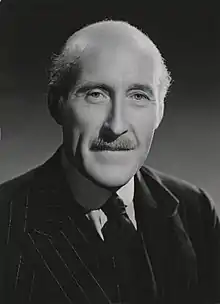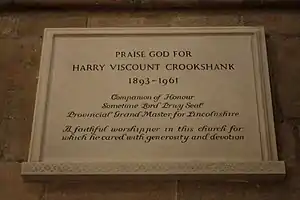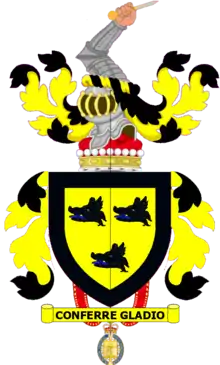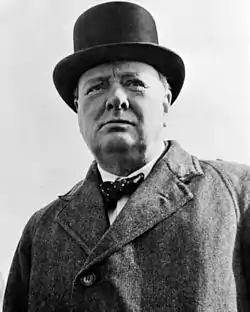Harry Crookshank
Harry Frederick Comfort Crookshank, 1st Viscount Crookshank, CH, PC (27 May 1893 – 17 October 1961), was a British Conservative politician. He was Minister of Health between 1951 and 1952 and Leader of the House of Commons between 1951 and 1955.
The Viscount Crookshank | |
|---|---|
 | |
| Minister of Health | |
| In office 30 October 1951 – 7 May 1952 | |
| Monarch | George VI Elizabeth II |
| Prime Minister | Winston Churchill |
| Preceded by | Hilary Marquand |
| Succeeded by | Iain Macleod |
| Leader of the House of Commons | |
| In office 30 October 1951 – 20 December 1955 | |
| Monarch | George VI Elizabeth II |
| Prime Minister | Winston Churchill Sir Anthony Eden |
| Preceded by | James Chuter Ede |
| Succeeded by | Rab Butler |
| Personal details | |
| Born | 27 May 1893 Cairo, Egypt |
| Died | 17 October 1961 (aged 68) Chelsea, London |
| Nationality | British |
| Political party | Conservative |
| Alma mater | Magdalen College, Oxford |

Background and education
Crookshank was born in Cairo, Egypt, the son of Harry Maule Crookshank and Emma, daughter of Major Samuel Comfort, of New York City. On his father's side, he descended from Alexander Crookshank, of County Longford, Ireland, who represented Belfast in the Irish House of Commons and served as a Justice of the Court of Common Pleas in Ireland. He was educated at Eton and Magdalen College, Oxford. In the First World War, he joined the Hampshire Regiment and served as a captain in the Grenadier Guards. On one occasion he was buried alive by an explosion for twenty minutes, and on another in 1916 he was castrated by shrapnel, requiring him to wear a surgical truss for the rest of his life.[1] He was awarded by Serbia the Order of the White Eagle and Gold Medal for Valour.[2]
He joined the Diplomatic Service in 1919 and worked at the British Embassy in Washington, D.C., until 1924.
Political career
Crookshank was elected Member of Parliament (MP) for Gainsborough in 1924, a seat he held for the next 32 years.[3] He entered the government as Under-Secretary of State for the Home Department in 1934 under Ramsay MacDonald. When Stanley Baldwin became prime minister in 1935 Crookshank was appointed Secretary for Mines, a post he retained when Neville Chamberlain became prime minister in 1937 until February 1939. In the latter year, he was sworn of the Privy Council[4] and made Financial Secretary to the Treasury. He continued in this post also when Winston Churchill came to power in 1940,[5] and was then Postmaster General under Churchill between 1943 and 1945. In 1942 he was offered the post of British Minister Resident in the Mediterranean at Algiers following the liberation of Algeria by Operation Torch but he declined, Harold Macmillan being appointed instead.[6]
When the Conservatives returned to office under Churchill in 1951, Crookshank was appointed Minister of Health and Leader of the House of Commons, with a seat in the cabinet. In 1952 exchanged his post at the Ministry of Health for the sinecure post of Lord Privy Seal, while he remained as Commons Leader. He continued in these two positions until December 1955, the last year under the premiership of Sir Anthony Eden. In the 1955 New Year Honours he was made a Companion of Honour.[7][8] He retired from the House of Commons in 1956[3] and was raised to the peerage as the Viscount Crookshank, of Gainsborough in the County of Lincoln, in January of that year.[9] He had been offered a peerage in February 1940 but declined, having considered it at the time an insult because his First World War wounds had left him incapable of fathering any heir to a title.[10]
Papers released by The National Archives, London, November 2007, show that Crookshank, with Harold Macmillan, led a faction within the Cabinet of Sir Winston Churchill's government, who opposed what they perceived to be an attempt to bounce the Cabinet into a premature decision to authorise a British thermonuclear bomb programme in July 1954.
Personal life
Lord Crookshank was a Scottish Rite Freemason and Grand Master of Lincolnshire.[11]
Incapable as result of his First World War wounds of fathering children, Crookshank was a lifelong bachelor. He was also (not publicly) known as a homosexual and caused a near scandal when a male lover of his was adopted as Conservative candidate for the Grimsby constituency in 1958 but later withdrawn.[10][12]
His home from 1937 was at 51 Pont Street, Kensington, London, where in 1947 he hosted a meeting of like-minded backbench MPs who unsuccessfully demanded Churchill's removal as Conservative Party leader.[10]
He died of cancer[10] at Chelsea, London, in October 1961, aged 68. The viscountcy died with him. Having been since 1960 High Steward of the City of Westminster, his funeral service took place at Westminster Abbey, followed by burial at Lincoln Cathedral.[10] His sister, Helen Elizabeth Comfort Crookshank (1895–1948), lies next to him.
 |
|
References
- Ball 2004, p. 41, 60
- Dictionary of National Biography, 1961-1970. Oxford University Press. 1971. p. 249. ISBN 0-19-865207-0.Article by Viscount Chandos.
- "leighrayment.com House of Commons: Gainsborough to Goole". Archived from the original on 13 July 2011. Retrieved 18 September 2010.
- "No. 34595". The London Gazette. 3 February 1939. p. 751.
- leighrayment.com Peerage: Cowper to Cutts of Gowran
- Horne, Alistair (1988). Macmillan Volume I: 1894-1956. Macmillan. pp. 151–160. ISBN 978-0-333-27691-4.
- "No. 40366". The London Gazette (Supplement). 1 January 1955. p. 28.
- leighrayment.com Companions of Honour Archived 26 September 2008 at the Wayback Machine
- "No. 40684". The London Gazette. 13 January 1956. p. 278.
- Oxford Dictionary of National Biography, Volume 14. Oxford University Press. 2004. p. 403.Article by S.J. Ball.
- Walton Hannah, Christian by Degrees (London: Britons Publishing Company, 1954), 211.
- The Conservative candidate for Grimsby at the 1959 and 1964 elections, Wilfred Pearson, was not the same man.
- Burke's Peerage. 1959.
Books cited
- Ball, Simon (2004). The Guardsmen. London: HarperCollins. ISBN 978-0-002-57110-4.CS1 maint: ref=harv (link) (a joint biography of Harold Macmillan, Lord Salisbury, Oliver Lyttelton and Crookshank)
External links
- Hansard 1803–2005: contributions in Parliament by Harry Crookshank
| Parliament of the United Kingdom | ||
|---|---|---|
| Preceded by Sir Richard Winfrey |
Member of Parliament for Gainsborough 1924–1956 |
Succeeded by Marcus Kimball |
| Political offices | ||
| Preceded by Douglas Hacking |
Under-Secretary of State for the Home Department 1934–1935 |
Succeeded by Euan Wallace |
| Preceded by Ernest Brown |
Secretary for Mines 1935–1939 |
Succeeded by Geoffrey Lloyd |
| Preceded by Euan Wallace |
Financial Secretary to the Treasury 1939–1943 |
Succeeded by Ralph Assheton |
| Preceded by William Morrison |
Postmaster General 1943–1945 |
Succeeded by The Earl of Listowel |
| Preceded by Hilary Marquand |
Minister of Health 1951–1952 |
Succeeded by Iain Macleod |
| Preceded by Chuter Ede |
Leader of the House of Commons 1951–1955 |
Succeeded by Rab Butler |
| Preceded by The Marquess of Salisbury |
Lord Privy Seal 1952–1955 | |
| Peerage of the United Kingdom | ||
| New creation | Viscount Crookshank 1956–1961 |
Extinct |
.svg.png.webp)
